The Intel Core i9-9990XE Review: All 14 Cores at 5.0 GHz
by Dr. Ian Cutress on October 28, 2019 10:00 AM ESTCPU Performance: Web and Legacy Tests
While more the focus of low-end and small form factor systems, web-based benchmarks are notoriously difficult to standardize. Modern web browsers are frequently updated, with no recourse to disable those updates, and as such there is difficulty in keeping a common platform. The fast paced nature of browser development means that version numbers (and performance) can change from week to week. Despite this, web tests are often a good measure of user experience: a lot of what most office work is today revolves around web applications, particularly email and office apps, but also interfaces and development environments. Our web tests include some of the industry standard tests, as well as a few popular but older tests.
We have also included our legacy benchmarks in this section, representing a stack of older code for popular benchmarks.
All of our benchmark results can also be found in our benchmark engine, Bench.
WebXPRT 3: Modern Real-World Web Tasks, including AI
The company behind the XPRT test suites, Principled Technologies, has recently released the latest web-test, and rather than attach a year to the name have just called it ‘3’. This latest test (as we started the suite) has built upon and developed the ethos of previous tests: user interaction, office compute, graph generation, list sorting, HTML5, image manipulation, and even goes as far as some AI testing.
For our benchmark, we run the standard test which goes through the benchmark list seven times and provides a final result. We run this standard test four times, and take an average.
Users can access the WebXPRT test at http://principledtechnologies.com/benchmarkxprt/webxprt/
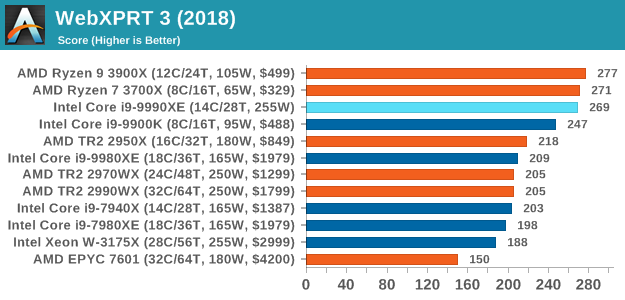
WebXPRT 2015: HTML5 and Javascript Web UX Testing
The older version of WebXPRT is the 2015 edition, which focuses on a slightly different set of web technologies and frameworks that are in use today. This is still a relevant test, especially for users interacting with not-the-latest web applications in the market, of which there are a lot. Web framework development is often very quick but with high turnover, meaning that frameworks are quickly developed, built-upon, used, and then developers move on to the next, and adjusting an application to a new framework is a difficult arduous task, especially with rapid development cycles. This leaves a lot of applications as ‘fixed-in-time’, and relevant to user experience for many years.
Similar to WebXPRT3, the main benchmark is a sectional run repeated seven times, with a final score. We repeat the whole thing four times, and average those final scores.
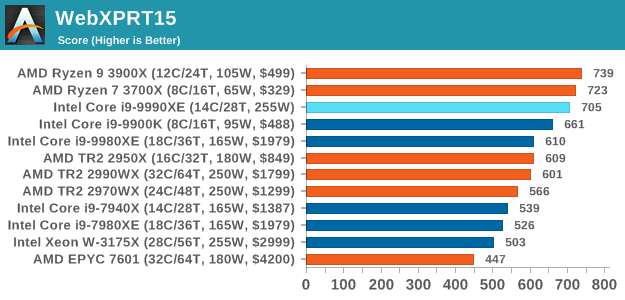
Speedometer 2: JavaScript Frameworks
Our newest web test is Speedometer 2, which is a accrued test over a series of javascript frameworks to do three simple things: built a list, enable each item in the list, and remove the list. All the frameworks implement the same visual cues, but obviously apply them from different coding angles.
Our test goes through the list of frameworks, and produces a final score indicative of ‘rpm’, one of the benchmarks internal metrics. We report this final score.
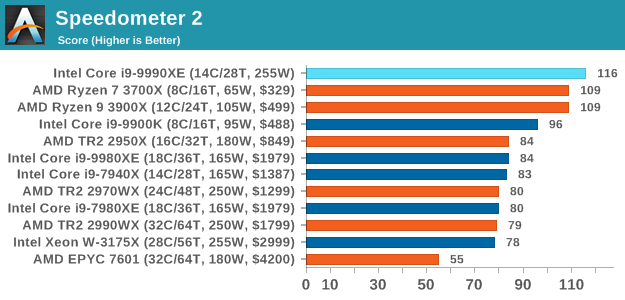
Google Octane 2.0: Core Web Compute
A popular web test for several years, but now no longer being updated, is Octane, developed by Google. Version 2.0 of the test performs the best part of two-dozen compute related tasks, such as regular expressions, cryptography, ray tracing, emulation, and Navier-Stokes physics calculations.
The test gives each sub-test a score and produces a geometric mean of the set as a final result. We run the full benchmark four times, and average the final results.
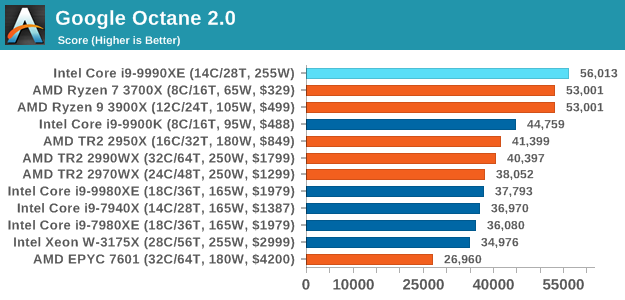
Mozilla Kraken 1.1: Core Web Compute
Even older than Octane is Kraken, this time developed by Mozilla. This is an older test that does similar computational mechanics, such as audio processing or image filtering. Kraken seems to produce a highly variable result depending on the browser version, as it is a test that is keenly optimized for.
The main benchmark runs through each of the sub-tests ten times and produces an average time to completion for each loop, given in milliseconds. We run the full benchmark four times and take an average of the time taken.
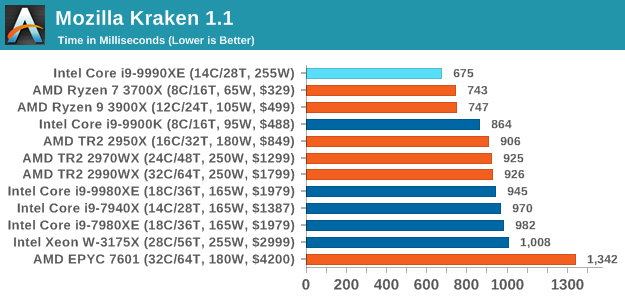
3DPM v1: Naïve Code Variant of 3DPM v2.1
The first legacy test in the suite is the first version of our 3DPM benchmark. This is the ultimate naïve version of the code, as if it was written by scientist with no knowledge of how computer hardware, compilers, or optimization works (which in fact, it was at the start). This represents a large body of scientific simulation out in the wild, where getting the answer is more important than it being fast (getting a result in 4 days is acceptable if it’s correct, rather than sending someone away for a year to learn to code and getting the result in 5 minutes).
In this version, the only real optimization was in the compiler flags (-O2, -fp:fast), compiling it in release mode, and enabling OpenMP in the main compute loops. The loops were not configured for function size, and one of the key slowdowns is false sharing in the cache. It also has long dependency chains based on the random number generation, which leads to relatively poor performance on specific compute microarchitectures.
3DPM v1 can be downloaded with our 3DPM v2 code here: 3DPMv2.1.rar (13.0 MB)
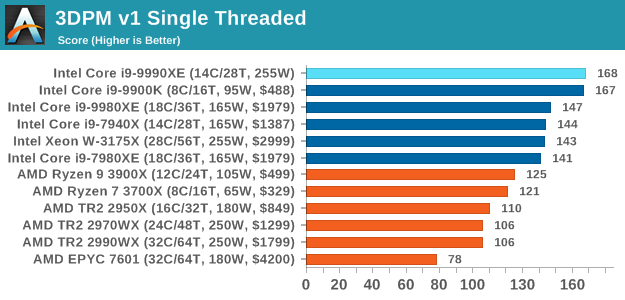
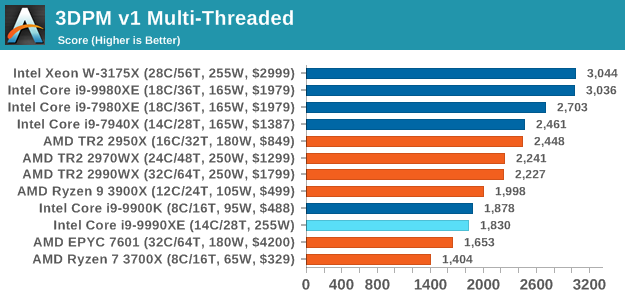
x264 HD 3.0: Older Transcode Test
This transcoding test is super old, and was used by Anand back in the day of Pentium 4 and Athlon II processors. Here a standardized 720p video is transcoded with a two-pass conversion, with the benchmark showing the frames-per-second of each pass. This benchmark is single-threaded, and between some micro-architectures we seem to actually hit an instructions-per-clock wall.
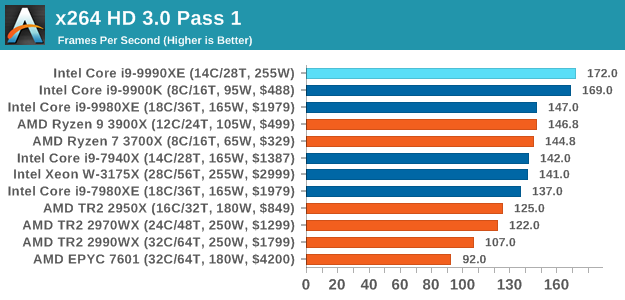
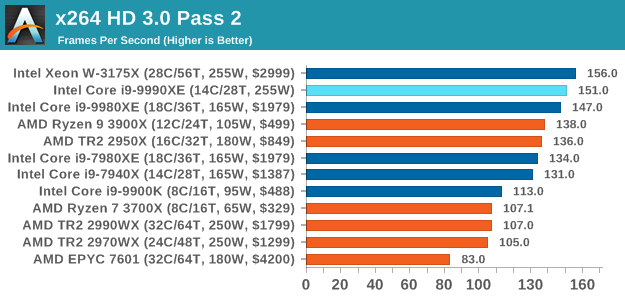










145 Comments
View All Comments
willis936 - Monday, October 28, 2019 - link
>but also pay experts and specialists to tune those systems for high latencyI believe this should read "low latency".
jospoortvliet - Tuesday, October 29, 2019 - link
Yup. And while correcting:> Against AMD counterparts, that 5.0 GHz frequency carves through anything like butter.
That is rather optimistic... the Intel is frequently bested by the 3700x and especially the 3900x - I would expect a 3950X might even win the majority of tests run here.
jospoortvliet - Tuesday, October 29, 2019 - link
I went ahead and did a quick count:* 3900X has 13 wins (7 more than 10%)
* 9990XE has 21 wins (10 more than 10%)
Now obviously the 9990XE is faster, but it better be with 2 more cores and 5 ghz and 400 watt power use and a price - well... ;-)
But it sure isn't the slam dunk it is described at - Ian writes like this monster wins in >90% of the tests, which it doesn't, not by a long shot. If it was readily available at $600 and had a TDP of 140W, I'd call it a winner, even if it doesn't *always* win. But if intel has to go THIS extreme and still loses in over 1/3rd of the graphs here at Anandtech, it is more a show of weakness if anything.
And all that while we await the 3950X and new gen Threadripper - it is good for Intel that they weren't out yet and part of the benchmark, otherwise the halo would be even harder to make out...
Netmsm - Tuesday, October 29, 2019 - link
Agree;I expected to read a completely impartial review, like always, but I feel some sort of inclination to bold strengths in a way that a true discussion of 9990xe's weaknesses is out of favor!
jgraham11 - Tuesday, October 29, 2019 - link
Agreed!Look at that amazing performance at 250W (which will probably run even hotter, just like the 9900k "stock (95W)" vs out of box settings(140W+)
Compared to the AMD 3900X at half the power(105W), that thing is a heater!
Same story as all the other recent articles about Intel chips:
Intel runs old games better, runs hotter, consumes more power, higher clock speed!
AMD runs new games better, runs cooler, consumes less power (in this case half at least), runs applications better
ballsystemlord - Wednesday, October 30, 2019 - link
I agree too. Ian was too excited when writing this review.I'm more concerned that we'll have to stare at this processor in the lineup from now on as each AMD TR3 processor is covered. That's totally unfair because this CPU is for auction only and in limited supply permanently.
Thus it'll look like Intel wins everything all the time. And then there are the people who will call this site a shill site because of that...
NikosD - Friday, November 1, 2019 - link
The whole article is another desperate move from Intel, just a few weeks before AMD releases Ryzen 3950X 16C/32T and new Threadripper 3rd gen.Unfortunately they found Anandtech and Dr. Ian Cutress again, to support their pathetic effort with some credibility.
And suddenly after publishing this kind of article, the problem moves from Intel's side to Anandtech's side.
My condolences.
peevee - Monday, October 28, 2019 - link
"This ultra-rare thing isn’t sold to consumers – Intel only sells it to select partners, and even then it is only sold via an auction, once per quarter, with no warranty from Intel."Pathetic strategy for bragging rights only...
fackamato - Monday, October 28, 2019 - link
I think you're in the wrong forums?Of course people will buy this if it brings value to them versus the price they have to pay.
bananaforscale - Thursday, October 31, 2019 - link
Sure, if value == bragging rights. Or if they have more money than sense.